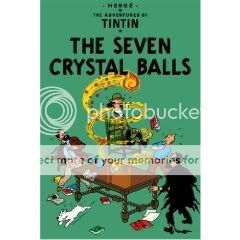The Adventures of Tintin: The Seven Crystal Balls
Hergé, writer/artist
Little, Brown and Company, 1975
62 pages
$10.99, not adjusted for inflation
You know what reading this reminded me of? Watching the Wachowski Bros. Speed Racer. Maybe it’s the luscious candy colors, maybe it’s the miraculously smooth line, maybe it’s the rounded figures, but in much the same way that Speed Racer aspired to be nothing but a wholistic yet obviously CGI world, Tintin is clearly a cartoon, yet draws your eyes in irresistibly and sensually, as though you could predict what would be behind every tree, what you’d see if you turned around and looked in the other direction, what the backs of each character look like when they’re facing front. I think what I’m trying to say is that it’s fluid? You could jump right in and move around. Obviously the panel transitions help a great deal: Hergé often adds what would appear to be extraneous frames of Tintin walking from here to there, or an extra beat or two during a conversation, just to give a slightly more total sense of Tintin’s world. He also ever-so-slightly violates the 180 degree rule now and then as his characters move from place to place–he does it as they shift direction so you don’t notice it as much, but it reinforces that sense that if you spun a camera all the way around them in any direction, that pastel world of lines and shapes and colors would be visible the whole time. Immersive, maybe that’s the word too. Man, what a stylist!
Plotwise it’s, y’know, kind of slight: The members of a Peruvian archaelogical expedition that unearthed the mummy of an Incan ruler are being systematically assaulted by some sort of gas or powder that’s knocking them into comas; the dispersal method appears to be shattered crystal balls. During the investigation, Tintin’s friend Professor Calculus is kidnapped. There’s a shootout—now that’s what kids’ entertainment needs these days!—but the kidnapper escapes with Calculus in tow. It actually is rather engaging for its simplicity (I was curious to discover just how the kidnapper’s getaway car dodged the cops), the comic business is often funny (I liked Snowy the dog’s ill-fated attempts to chase Captain Haddock’s cat), and I guess it’s just my ignorance of the European album format that had me feeling gypped that the book ended without resolving the story. Newsflash: Tintin is a fun comic.
Tags: comics, comics reviews, Comics Time, reviews


Many of TinTin’s albums are self-contained adventures, though Herge was not averse to doing longer tales that take up two books (another example: Destination Moon and its follow-up Explorers on the Moon). It’s been ages since I’ve read one of these enjoyable comics – got a whole batch of ’em when they were first released in America back in the mid-seventies – but now you’ve got me wanting to pick up Red Rackham’s Treasure or The Castifiore Emerald again . . .
I wanna take a moment to say how excited I am that you reviewed a Tintin book. I dunno why my browser JUST showed me this, but it did and I have a warm feeling in my tummy.
Please do more.
Did you ever read Prisoners of the Suns?
Also: pingback: http://islingtoncomic.blogspot.co.uk/2012/05/tintin-seven-crystal-balls-prisoners-of.html